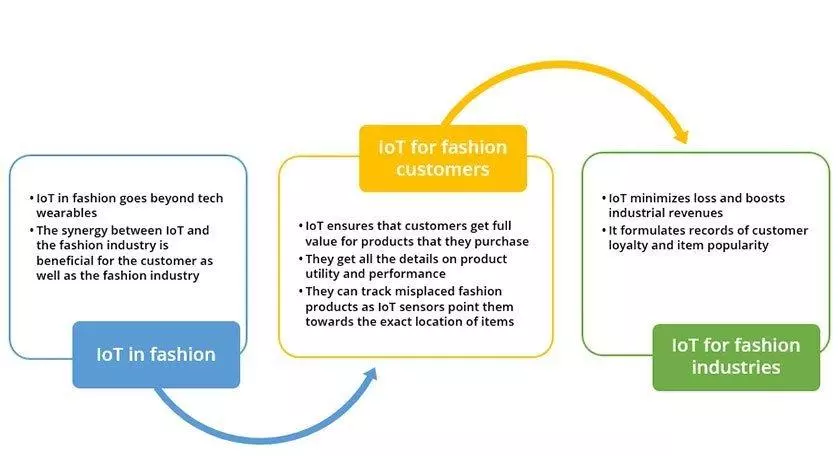Internet of Things (IoT) has found its way into the fashion industry taking it to a whole new level. This revolutionary technology has something in store for everyone – fashion buffs, designers, retailers, and fashion market in general.
Most of us, at one point or the other, have read or heard about IoT and the impact it’s creating across various industrial sectors. Right from transforming manufacturing to easing production and delivery, and from automating warehouses to revolutionizing healthcare. You name it and IoT has done it. However, have you ever thought of IoT disrupting the fashion industry? If you haven’t, now is the time. According to Report buyer, “there were 968,000 smart clothing units sold in 2015, a number that will reach 24.75 billion in 2021.” Today, more and more fashion industries are jumping on to the IoT bandwagon, mostly because they’ve realized that no growth can occur if they do not keep pace with the technological advancements. This is why people from the world of fashion are showing keen interest in leveraging this revolutionary technology.

IoT in fashion
Gone are the days when IoT and its applications were limited to cars, wearable tech, and smart homes alone. Today, IoT is in the process of transforming one of the biggest and most glamorous of industries -the fashion industry! Did you ever think of the possibility of internet connected clothes? Well, thanks to IoT, we’re close to making this a reality. This technological blow up in fashion industry was first initiated by a partnership between EVRYTHNG, an eminent IoT platform, and Avery Dennison, a revered branding, labeling, and RFID solutions leader. It’s important at this point to highlight that by IoT in fashion, we don’t just mean tech wearables like Fitbit or Google glasses. We’re talking about other stuff too, like invisible sensors being stitched into the very fabric of clothes. Besides, billions of inter-connected apparels will be able to perform functions like informing you about the materials of the product, locating itself when lost, and giving you style tips.
IoT for Fashion Customers
Everybody knows that fashionistas are very particular about their style statement and branding. They spend a lot of time pilfering through products that have the right value. Customers today want to research into all possible details before spending their money on clothes and other fashion products. IoT makes this process convenient by updating customers with all such information. For instance, prior to a purchase, IoT sensors embedded on a product’s package can inform you about details like the place of manufacturing and materials used. This is especially useful for the environmentally-conscious customers. Another factor that concerns customers is the hassle involved in after-sales services. However, customers will no longer have to go through this time-consuming ordeal. Thanks to IoT, industries can facilitate speedy production and timely delivery, ensuring maximum customer satisfaction. Another advantage of IoT is its tracking feature that can help customers track lost clothes and accessories by directing them to the exact location they’ve misplaced it. Future developments of IoT in fashion include clothes that will enable weather prediction and detection of health issues.
IoT for Fashion Industries
If IoT has numerous benefits for the customer, it has even more advantages in store for designers, suppliers, and retailers. Most of the industry’s resources go towards inventory management, seamless production, and customer satisfaction. What IoT does is that it simplifies these tasks for you. It minimizes loss and allows efficient inventory management by its tracking feature. Moreover, it keeps track of fraud through RFID tags and barcodes. It even formulates records of customer loyalty and item popularity, ensuring that you are aware of current customer trends. Today more and more retailers are integrating IoT in their systems. The fashion industry has followed their example and made this switch too. The global corporation, Avery Dennison, has already taken the leap by unveiling what is known as a ‘smart bomber jacket.’ Apart from having an NFC chip that facilitates contactless payment, the jacket also gives you entry into exclusive NY clubs and to designer fashion shows. Talking about designers, designer Rebecca Minkoff has done what no other designer has. Her “connected stores” all over NY merge the online world of shopping with the physical world. Mirrors set up all around the store, provide users access to runway shows and photos of latest looks. Users can also browse products they like and request for their fitting. Once in the dressing room, customers will find the product they requested, in addition to tips from stylists. Users can browse between handbags, clothes, and accessories all through a simple touch. This way, customers are provided with a seamless and digitally connected shopping experience.
Even though IoT is still in its nascent stage of development, the positive impact it has had on nearly all aspects of industries is compelling. However, the complete synergy between fashion and technology has yet to unravel its full potential and mostly depends on the fashion industries that dare to venture into the possibilities and invest in new capabilities. While IoT is already transforming several fashion businesses, the pertinent question is - has it transformed yours?




Leave your comments
Post comment as a guest